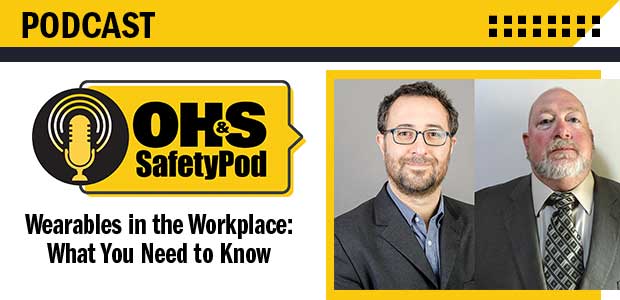
Episode 73
Wearables in the Workplace: What You Need to Know
In this episode, Editor Sydny Shepard is joined by two professionals from NIOSH to discuss how wearable devices are impacting the safety industry.
- By Sydny Shepard
- May 24, 2021
Internet of Things, Network Connected Devices, Wearables… these are all words and phrases that you have probably heard referenced in the last decade and they have been rapidly gaining speed as access to information and data becomes the ultimate source of power in workplaces.
I know I had a lot of questions about how wearables are impacting the safety industry – so I figured you did, too. On today’s episode, you’ll hear my interview with Emanuele Cauda and John Snawder, both professionals working with the National Institute for Occupational Safety and Health, or NIOSH. We discuss many of the topics you might be wondering about when it comes to wearables, but first, let’s talk a little more about our guests:
John Snawder received his Ph.D. degree from Mississippi State University in 1990 and did post-doctoral work at the US Food and Drug Administration, National Center for Toxicological Research in Jefferson, AR. He has been a Diplomate of the American Board of Toxicology since 1995 and served on their Board of Directors from 2008 to 2012. Since 1992, he has worked at NIOSH as a research toxicologist. John is the co-Director of the NIOSH Center for Direct Reading and Sensor Technology and is the Leader of the Biological Monitoring Research Team in the Health Effects Division of NIOSH.
Dr. Emanuele Cauda is a Senior Research Engineer at National Institute for Occupational Safety and Health (NIOSH), in Pittsburgh (PA). Dr. Cauda’s research focuses on characterizing, monitoring, and controlling aerosols present in occupational environments and specifically respirable dust, silica, and diesel particulate matter. Dr. Cauda is currently the principal investigator of a NIOSH project titled “Advancing exposure monitoring for airborne particulates in mining”. Dr. Cauda is also the co-Director of the NIOSH Center for Direct Reading and Sensor Technologies. In the frame of the Center, he coordinates several activities on the selection and use of advanced monitoring techniques for aerosols, gas and vapors, fatigue, and other hazards. One of the current initiatives of the Center is called “Right Sensors Used Right”. Dr. Cauda is interested in the several aspects related to direct reading methodologies and sensors including human-technology interaction, data processing and modeling, and ethical considerations.
So, how do the professionals define wearables? What are the benefits of them? The cons? If you are thinking of using them, what’s the best way to enter into conversations about integrating wearable devices on your worksite? Listen to this episode to find out!
Download, stream and listen to OH&S SafetyPod on Apple Podcasts, Google Podcasts, Stitcher, Spotify and more.
About the Author
Sydny Shepard is the former editor of Occupational Health & Safety.